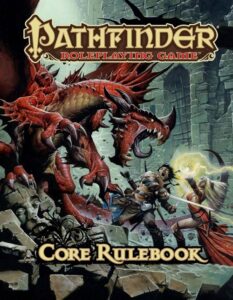We tire of the clickbait headlines supposing that D&D 5E should be replaced with some new game that “fixes everything wrong with 5E.” The conceit in each case is that we, the people who run and play the games, are (1) unsatisfied with D&D 5E, (2) incapable of creatively working around problems ourselves, and (3) have never tried any other system, version, or setting that we might prefer for the same experience. It belittles our intelligence and should be seen for the transparent marketing that it is.
And yet, a franchise or influencer is born every time the marketing succeeds, and success seldom delivers the promised replacement or improvements.
To turn this argument around, why does D&D 5E endure? Why do Kickstarter darlings fail to deliver a better experience? Why don’t more of us play Dragonbane or Runequest (or any other system we care to name) games if they are so much more fun?
In the first place, D&D 5E is run by a more successful business than most other game companies. We should not expect a small studio or individual to effectively compete with a large corporation controlling armies of creative talent, massive advertising budgets, and intellectual property the likes of which most of us aspire to produce even once in our lifetimes. This is not to say other creative options do not exist, but if we compare them all to D&D 5e, production is an obvious difference.
Looking past production, assuming we really don’t mind, if we might run independent games like Shadowdark or The Burning Wheel, or take a chance on a so called Fantasy Heartbreaker, there are only two outcomes:
- The game offers a similar experience to D&D 5E
- The game offers a different experience than D&D 5E
The second option is probably best, and it is how OSR and Band of Blades games succeed. If we really aren’t happy playing D&D 5E, perhaps D&D 5E isn’t what we like! Our newfound interest is a good thing, but a different experience should not be seen as fixing anything about 5E. We may not want to accept that our tastes change nor that we have different interests from other players, and this can be tough, but it doesn’t misrepresent what the new game is.
 The first option means someone has created a D&D 5E hack, and claims it is such a great departure from D&D 5E that it merits replacing D&D 5E. This sort-of happened once before, as Pathfinder used the D&D 3.5 open gaming license and became the top selling game in 2011-2014. However, it succeeded largely because D&D’s owners stopped publishing D&D 3.5 in 2007 and the folks at Paizo correctly concluded that there was still a large market for D&D 3.5 games. It means also that D&D 3.5 was great for a lot of players – Pathfinder was good because D&D 3.5 was good.
The first option means someone has created a D&D 5E hack, and claims it is such a great departure from D&D 5E that it merits replacing D&D 5E. This sort-of happened once before, as Pathfinder used the D&D 3.5 open gaming license and became the top selling game in 2011-2014. However, it succeeded largely because D&D’s owners stopped publishing D&D 3.5 in 2007 and the folks at Paizo correctly concluded that there was still a large market for D&D 3.5 games. It means also that D&D 3.5 was great for a lot of players – Pathfinder was good because D&D 3.5 was good.
So, if you are seeking a game to replace D&D 5E, first decide if D&D 5E is good for your group. If it is, then there is nothing to replace! The 5E killer is killer 5E – we have the option under the open gaming licenses to develop our own D&D 5E in nearly any way we want. It belongs to us, the players!
If D&D 5E is not good, then try other games or develop your own, but do not seek to emulate D&D 5E. If it’s not what we want to play, then fixing or replacing it is not our goal.
